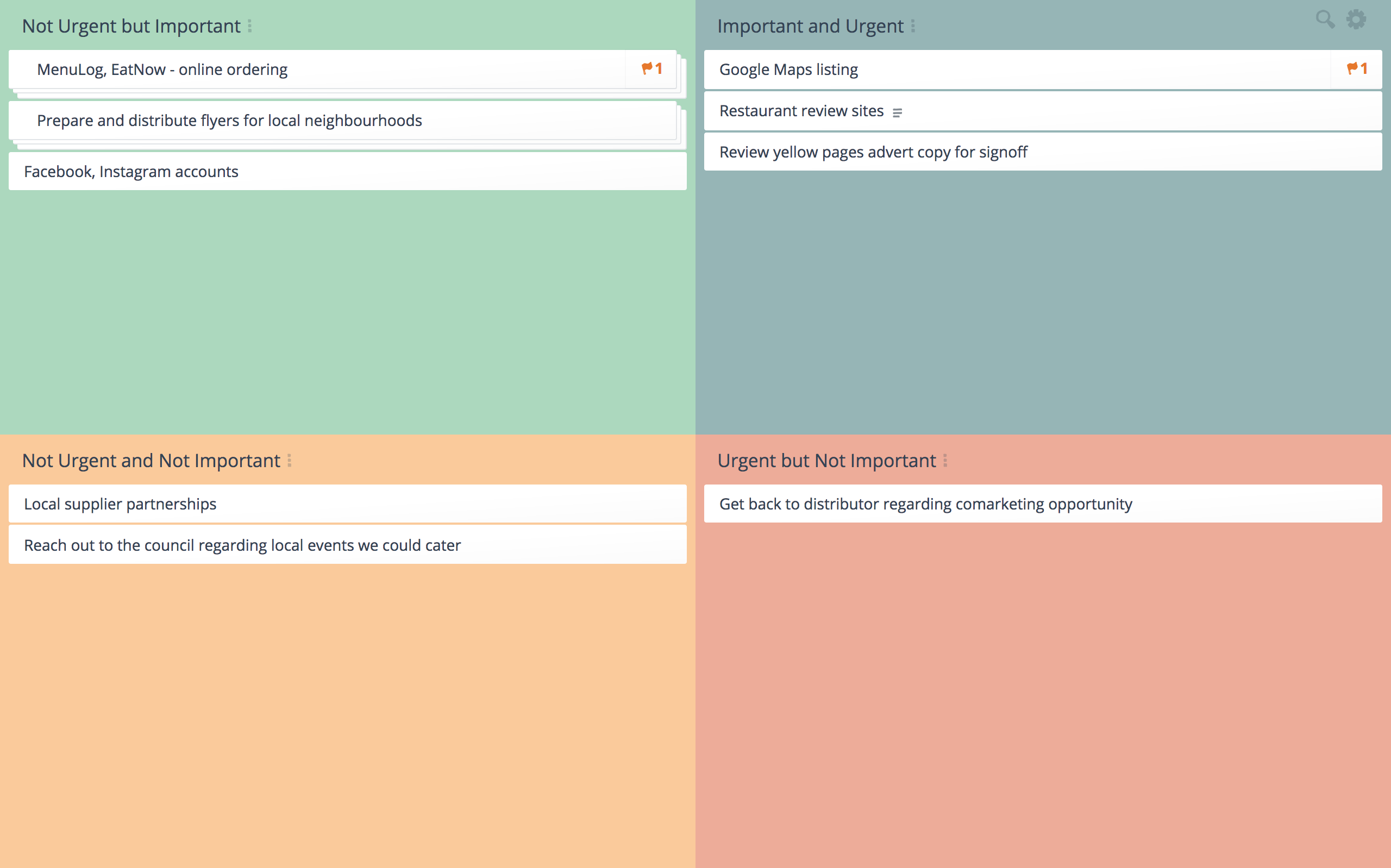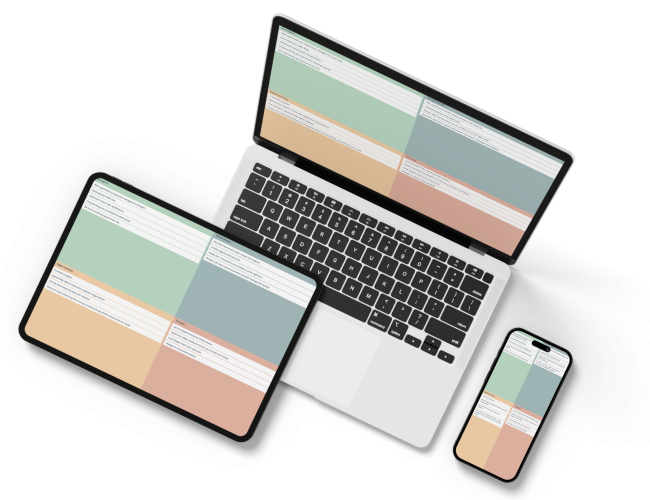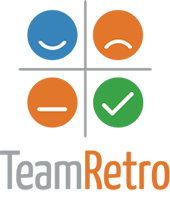
What is the Urgent Important Matrix?
An Urgent Important Matrix is a simple but effective tool for prioritizing your to-do list based on the level of urgency and importance of each task. It’s is sometimes referred to as the ‘Eisenhower Matrix’ or ‘Eisenhower Decision Matrix’ and is one of the easiest time management strategies to implement.
The latter two names refer to one of history’s most “efficient” US Presidents, Dwight Eisenhower, who famously quipped “I have two kinds of problems: the urgent and the important. The urgent are not important, and the important are never urgent.” (learn more)
When you’re working with limited resources, you can’t just focus on getting lots of work done; you need to focus on getting the RIGHT things done.
Why Use the Urgent Important Matrix?
An Urgent Important Analysis helps you to rapidly identify the activities that you should focus on, along with the ones you should ignore. It challenges the role of habitual activities and allows you to regain control of your environment and external demands, rather than allow them to control you. By filtering out “busy” activities that provide minimal value to long term goals, you free up time for things that matter.
Developing an Important vs. Urgent Matrix doesn’t require specialized training and has minimal cost, except for the time of those involved.
- Impact effort matrix
- Action priority matrix
- Carefully select participants to provide expert knowledge but also a fresh perspective.
- Use technology to involve critical people in different locations rather than miss their contribution.
- Minimize Groupthink by brainstorming tasks individually then combining to get the overall picture.
- Be specific rather than broad when capturing tasks.
- Communicate outcomes to stakeholders and regularly update progress on actions.
Who Can Use an Urgent Important Matrix?
Because the technique is so simple and versatile, it’s applicable to all levels of tasks from daily to-do lists through to strategic action plans. Development of an Urgent vs. Important chart is useful for:
- All industries
- All departments
- Existing and new businesses
- Teams and Individuals
Urgent Important Matrix Template
The template for an Urgent Important Matrix is a simple 2 x 2 square. The resulting four quadrants reflect the degree of urgency and importance of individual tasks. The vertical axis shows ‘Importance;’ the horizontal axis, ‘Urgency.’
This handy tool relies on the answer to just two questions:
- Is a task important?
- Is a task urgent?
Each task is then positioned on the prioritization matrix, thus providing a visual representation of which critical activities you should focus your resources and effort on, and which are essentially distractions.
Important but Not Urgent – Plans
Important but not Urgent activities might include:
- Longer term planning
- Work that directly contributes towards goals and objectives
- Risk analysis
- Relationship and team building
- Education and training
- Proactive maintenance
- Creating a budget and savings plan
Invest more of your time in this quadrant to help prevent and eliminate many of the urgent activities in Q2 and balance the demands in Q4.
Not Urgent and Not Important – Distractions
Not Urgent and Not Important tasks might include:
- Excessive or irrelevant email
- Personal phone calls
- Social media usage
- Unimportant or unproductive meetings
- Anything that causes you to procrastinate on, or delay, Q1 tasks
Reduce, or completely avoid spending time, effort, and resources on activities in this quadrant if where possible.
Urgent and Important – Crises
These are things we have to manage right now and have a relatively short-term focus.
Important and Urgent tasks might include:
- Fire-fighting & pressing problems
- deadlines
- Equipment breakdowns
- Client complaints
- Items from Q1 that weren’t dealt with
By spending more time in Q1, developing systems and plans, you can make many of these tasks more efficient or even eliminate them outright.
Urgent but Not Important – Interruptions
Urgent but not Important tasks might include:
- Regular meetings and reports
- Phone calls and text messages
- Most emails (although some emails could be urgent and important)
- Requests from others that don’t directly contribute to your objectives
- Tasks that “We’ve always done this way” that are ineffective
Renegotiate deadlines, delegate where possible, and challenge the status quo of “regular” activities that don’t necessarily add value, e.g., reports that no one reads or actions.
How to Do Effective Urgent Important Analysis
Understanding the clear difference between urgent and important is the key to obtaining valuable outcomes.
Urgent means that a task requires immediate attention. They are things that can’t be put off and are often for others. The negative consequences of not doing them are immediate. Urgent tasks are reactive, defensive, hurried, short term, and have a narrow focus.
Important tasks contribute to our long-term mission, values, and goals. They are sometimes urgent but usually aren’t. Important activities are proactive and lead to long-term benefits. The negative consequences of not doing them tend to accumulate over a longer period and can then become a crisis.
Actions plans should focus on Q1 and Q2. Q3 is dealt with as a lesser priority, and many tasks from Q4 should be eliminated completely.
As with most brainstorming activities, the time required to conduct an effective Urgent Vs Important analysis varies depending on the organization, the size of the group, and the focus of the session. However, there is no reason why you can’t brainstorm, group position, plan actions, and write up a consolidated action plan in less than an hour or two.

Objectives
Define a clear objective for the Urgent Important Analysis.

Brainstorm
Identify all the current tasks involved in the activity.

Group
Group tasks that are essentially the same.

Position
Assess their urgency and importance of each task and place in the relevant quadrant.

Action Plan
Create an action for each task and assign responsibility and timeframes. Focus on Q1 & Q2 first.

Share and Communicate
Generate a report then share and communicate the outcomes of the session, including the action plan, to relevant stakeholders.
All Urgent Important exercises should begin by stating the objective of the activity and ensuring all participants are clear on the scope so they can focus their efforts.
The objective should define whether the Urgent Important Matrix is focused on the strategic, tactical, project, product/service, or personal level and have a clear timeframe (day, week, month, one or more years.)
Examples of Urgent Important Matrix Objectives:
- Prioritize actions from our SWOT session
- Develop team priorities for the XYZ project
- Map out an individual’s schedule to achieve milestones in their performance plan
Gather ideas individually or as a group using a whiteboard, post-it notes, or an online tool like GroupMap.
List all of the activities, tasks, and projects participants think need to be done. Try to include everything that takes up time, however trivial they might seem.
One you have everybody’s ideas they need to be organized. Spend time culling duplicates, merging similar ideas, and discarding those not in scope.
This step is more time consuming if the brainstorming was performed individually, or completed at different times and locations. Using a software tool like GroupMap to group ideas can significantly reduce the time and effort required in this step and result in a better outcome.
Discuss the tasks and activities and their value to the objectives. Place each one in the relevant quadrant according to their agreed importance and urgency. The content of each quadrant feeds directly into your Urgent vs. Important Action Plan.
Individuals can position items independently and then combine their ideas, or this step can be done as a group. Where there are disagreements about where tasks should be placed, participants should explain their reasoning.
Assign tasks and activities to individuals or teams with clear timeframes.
Address activities in Q2 (Urgent and Important) first then Q1 (Important but Not Urgent)
When assigning activities, estimate the time for completion and ensure those tasked with Q1 activities have the time and resources to complete them. Managing these tasks well means fewer crises to manage later which is good for everyone long term.
Have a robust discussion on the continued relevance of activities in Q4 (Urgent but not Important) and acceptable behavior regarding activities in Q3 (Not Urgent or Important).
Distribute the resulting action plan from the Urgent vs. Important Matrix and monitor progress and effectiveness on a regular basis.
GroupMap automatically generates visually appealing reports and action plans in several formats for distribution, saving time and effort after the analysis.

Save Effort, Time and Money with GroupMap
GroupMap offers more than just an online digital whiteboard—it’s innovative platform is designed to enhance the quality of your team’s decisions. With features that prevent bias and make facilitation seamless, GroupMap ensures no single voice dominates and ensures productive, inclusive conversations.
Its intuitive interface is easy for anyone to use, and its scalable design supports small teams and large groups whether they are face to face or around the globe. Customisable templates and workflows keep discussions focused on objectives, helping you drive actionable outcomes each and every time.
Create your first map and invite people in to start sharing their thoughts NOW.
Experience the power of GroupMap with our FREE 14 day trial.
Your free trial gives you access to all of our features, no credit card required.
